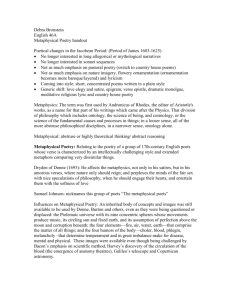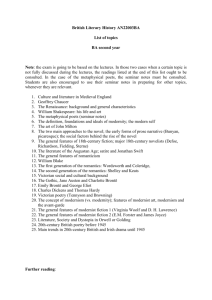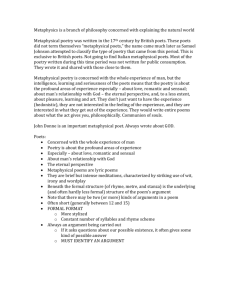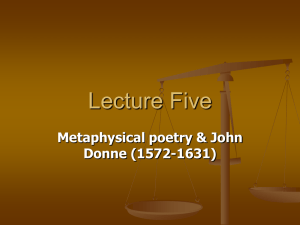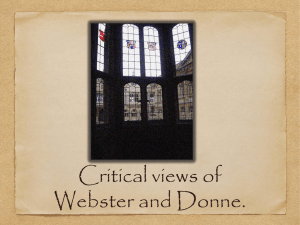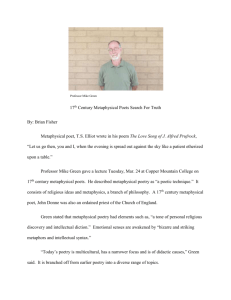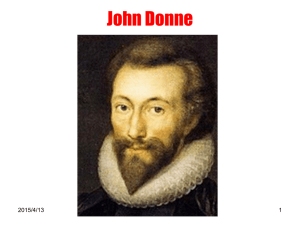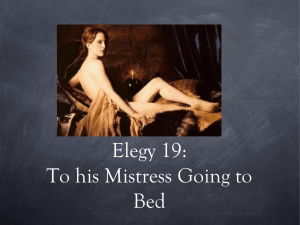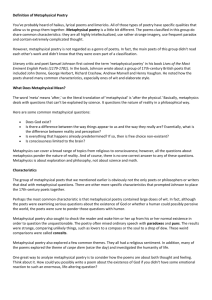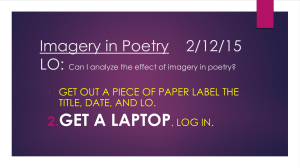Donne
advertisement
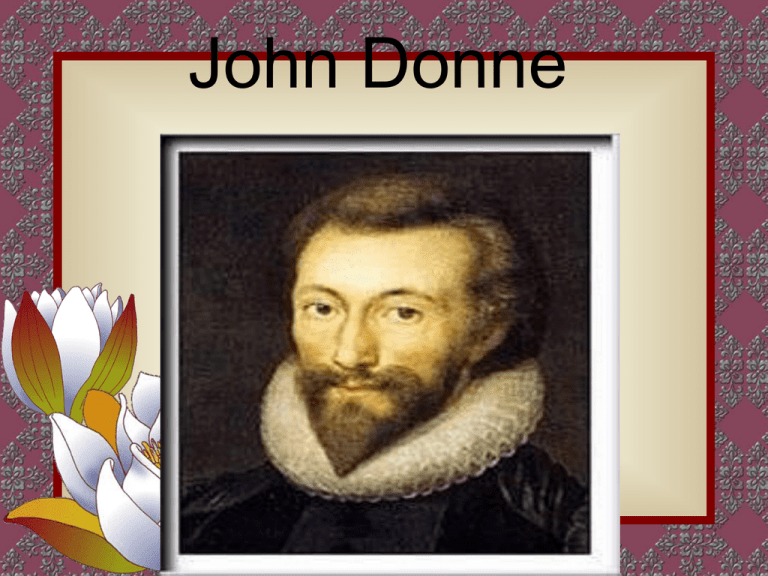
John Donne Subject: English literature Francis Bacon • • • • • • • • Objectives: help the student to know about John Donne, the person, his works, his imagery and style and the discussion of selected works. Focus: 1. Donne’s imagery. 2. the style of Donne. 3.what are the different aspects between the literature of Elizabethan period and the literature of the Revolution period? Difficult Points: satire, elegy, stanza, conceit ,Metaphysical poetry , wit. Procedures: 1. A brief introduction to the biography. (40 min.) 2. Donne’s imagery and style.(15min) 3. what are the different aspects between the literature of Elizabethan period and the literature of the Revolution period? (15m 4. The Main points of the selected works. (45 min.) 5.Relevant exercise. (45 min.) the period of Revolution and Restoration • The 17th century was one of the most tempestuous period in English history. It was a period when absolute monarchy impeded the further development of capitalism in England and the bourgeoisie could no longer bear the way of landed nobility. The contradictions between the feudal system and the bourgeoisie had reached its peak and resulted in a revolutionary outburst. Elizabeth died in 1603 and James I came to the throne—a succession that marks the change from a united England to a divided England. The government of James I was a despotism (专制主义)based upon the theory of the divine right of kings. In the next reign ( Charles I succeeded James I in 1625) the religious tyranny of Archbishop Laud was added to the political tyranny of the king. Against this royal arrogance, the Puritans offered another theory of divine right, the divine right of the individual conscience. They renounced a life of joy in this world, in hope of an joy in the world to come. There were religious division and confusion and a long bitter struggle between the people’s Parliament and the Throne—puritans(清教徒) fighting against the Cavaliers who helped the king. In 1649 Charles I was beheaded. England became a commonwealth under the leadership of Oliver Cromwell. In 1653 Oliver Cromwell imposed a military dictatorship on the country: after his death monarchy was again restored ( 1660) it was called the period of the Restoration, which meant, in effect, the restoration of all that was Objectionable in monarchy. Another crisis came in the Revolution of 1688, aroused by the attempt of James II to establish another despotism (专制主义 ) in Church and state, invited Prince William of Orange( husband of the king’s daughter Mary ) to the English throne. That revolution meant three things: the supremacy (自高无上)of Parliament, the beginning of modern England, and the final triumph of the principle of political liberty for which the Puritans had fought and suffered hardship for a hundred years . Literary Characteristics • In literature also the Puritans Age was one of confusion, due to the breaking up of old ideals. Medieval standards of chivalry( 骑 士 ), the impossible loves and romances perished no less surely than the ideal of a national church. The Puritans believed in simplicity of life. They disapproved of the sonnets and the love poetry written in the previous period. In 1642 the theatres were closed. The Bible became now the one book of the people. The Puritan influence in general tended to suppress literary art. Yet this hard, stern sect produced a great poet, John Milton, and a great prose writer, John Bunyan. Poetry took new and startling forms in Donne and Herbert, and prose became as somber as Burton’s Anatomy of Melancholy. The spiritual gloom which sooner or later fastens upon all the writers of this age, and which is unjustly attributed to Puritan influence, is due to the breaking up of accepted standards in government and religion.. • This so called gloomy age prdoduced some minor poems of exquisite workmanship, and one great master of verse whose work would glority any age or people, John Miltom, in whom the indomitable Puritan spirit finds its noblest expression Restoration created its own literature, that was often witty and clever, but on the whole immoral and cynical. The most popular was that of comedy whose chief aim was to entertain the licentious aristocrats.(贵族作风). John Dryden , critic, poet and playwright was the most distinguished literary figure of that time . John Donne (1572—1631) A more thoroughly characteristic figure of the early seventeenth century is John Donne. Born of a family with a strong Roman Catholic tradition, he was sent, while very young, to Trinity college, Cambridge, later, as a member of Lincon’s Inn, he read voraciously() and lived gaily. He went with Essex on the expedition to Cadiz in 1596, an enterprise that ranked for daring with the repulse of the Armada, and later became secretary to Lord Keeper Egerton. Before this he had written a body of poetry which, though not published until after his death, circulated in manuscript, and like Wyatt’s and Surrey’s, had an immense influence on younger poets. Part of this poetry is in such classical forms as satires, elegies, and epistles—though its style has anything but classical smoothness—and part is written in lyrical forms of . extraordinary varietyand seriously in love About 1601 Donne fell passionately with the niece of the Lord Keeper, married her, and was imprisoned for a time by angry father-in-law. For several years after his release he and his growing family were dependent on friends and patrons; at the persuasion of influential admirers, he entered the church in 1615, where he rose rapidly to be Dean of Saint Paul’s, and the most famous preacher of his time. After the death of his wife in 1617 he fell more and more under the shadow of a terrible spiritual gloom. 玄学派诗人描绘了一个高级智者诗派,他以进取,自然和自负的特征,使 用不适宜的直喻,复杂的思维 过多的反论,在表达方式上故意使用苛刻的 文笔和僵化的个性为标志, 其主题是爱情,死亡和宗教,根据他们所说, 宇宙间的万物彼此都围绕在上帝周围。 骑士学派是保皇派(royalist)他们 的诗歌以谦和而威严为标志, 他们是充满感情的诗人,主题 是爱情和宗教, 他们的诗歌兴盛于17世纪初和中期的宫廷 反映了生活的奢侈和懒散。 Donne ‘s religious poems and his magnificent sermons (布道) reached astounding heights of subtlety and intensity. His prose style, involuted (纠缠不清,错综复杂) and ornate(华丽),cumulative (渐增的) and Ciceronian (西塞罗,古罗马雄辩家,政治家和哲学家, 古典的, 有韵味的)is one of the more glorious monuments to the spirit of the early seventeenth century. In the literal history, he is regarded one of the most important poets of Metaphysical poets (玄学派诗人),during the reign of Charles I , the poets were divided into two kinds , one is metaphysical, one is cavalier poets. Donne’s imagery • It has always impressed readers by its range and variety and its avoidance of the conventionally ornamental. Donne had a different conception of the function of imagery from that of the other Elizabethan poets. The purpose of an image in his poetry is to define the emotional experience by an intellectual parallel. His images must be followed logically; point by point they fit the emotion illustrated. And he identifies his own interests, so that he is always illustrating one face of his experience by another. Everything that played an important part in his life or left its mark upon his mind occurs in the poetry, not as subject-matter, but as imagery. His subject-matter was confined almost entirely to various aspects of love and of religion; but his imagery reveals the width of his intellectual explorations .some of Donne’s most powerful images are learned and scientific. The works of Donne • Songs and Sonnets (歌与十四行诗 )this is his love poem collection, published in 1633 after he died, his love poems is divided into two groups ,the first group is to use cynical (愤世厌俗的) tone to satirize women’s inconstancy(不专多变) , the second group is to express his genuine sentiment(真实的 情感)to love, he even thought the love should be “sanctifies love”(神圣的爱). Some terms • stanza, a group of lines forming a structural unit or division of a poem. Stanzas may be units of form established through similarity in the number of lines, length of lines, meter and rhyme scheme; or stanza may exist as logical units determined by their thought or content. conceit ,from the Italian concetto, “concept’ or “idea”; used in Renaissance poetry to mean a precise and detailed comparison of something more remote or abstract with something more present or concrete, and often detailed through a chain of metaphors or similes. Metaphysical poetry • the term is commonly used to designate the works of the 17th century writers who wrote under the influence of John Donne. Pressured by the harsh, uncomfortable, and curious age, the metaphysical poets sought to shat terms and replace them with new philosophies, new sciences, new worlds and new poetry. Thus with the rebellious spirit, they tried to break away from the conventional fashion of Elizabethan love poetry, in particular the Petrarchan tradition, which is full of refined language, polished rhyming schemes and eulogy to ideal love, and favored in poetry for a more colloquial language and tone, a tightness of expression and the single-minded working out of a theme or argument. Some questions • 1. why does the poet say that death is the “slave to fate, chance, kings and desperate men”? • 2. what does the poet mean when he says “we wake eternally” after one short sleep?
